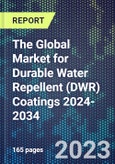Durable Water Repellent (DWR) Coatings create hydrophobic surfaces that repel water but allow water vapor to pass through. Fluoropolymers like PTFE are the most common type of chemistry used for DWR coatings due to their non-reactivity and excellent water repellency, but environmental concerns are shifting focus to hydrocarbons, silicones, nanocoatings, bio-based alternatives and smart coatings. Textiles are the largest application segment. Major factors driving growth are demand for water-resistant fabrics and the need to extend building lifespans by preventing water damage and mould growth.
Report contents include:
- Coatings analysis including chemistry, properties, application process and environmental issues. DWR coatings types covered include:
- Fluoropolymers.
- PTFE (polytetrafluoroethylene).
- Fluorinated acrylates/methacrylates.
- Shorter-chain fluorotelomer-based polymers.
- Branched fluoropolymers.
- Plasma-induced grafting.
- Hydrocarbons.
- Paraffins.
- Polyurethanes
- Silicones, Silanes, & Siloxanes.
- Polydimethylsiloxane (PDMS).
- Modified silicones.
- Block copolymers.
- Nanocoatings.
- Hybrid coatings.
- Bio-based
- Wax emulsions.
- Aliphatic polyesters.
- Chitosan.
- Protein-based.
- Plant-derived C6, C8, and C10 chemistry platforms.
- Lignin-derived polymers.
- Nanoscale citrus-derived.
- Smart DWR coatings
- Temperature-responsive DWR coatings.
- pH-responsive DWR coatings.
- Light-responsive DWR coatings.
- Self-healing DWR coatings.
- Conductive DWR coatings.
- Fluoropolymers.
- Limitations of current DWR chemistries.
- Market drivers and challenges.
- Analysis of markets for DWR coatings including:
- Outdoor apparel
- Fashion apparel
- Performance footwear
- Workwear
- Medical wear
- Military apparel
- Upholstery
- Awnings, tents, and bags
- Transportation
- Building & Construction
- Electronics
- Industrial coatings.
- Analysis of key market players, textile mills and fabric finishers providing durable water repellent (DWR) treatments.
- Global market revenues for DWR Coatings, by chemistry, end-use market and regions, historical and forecast to 2034.
- Profiles of 144 chemical manufacturers, product developers, coating producers and start-ups. Companies profiled include 3M, Actnano, Amphico, BASF, Dimpora, Dow, Earthodic, Elkem, Green Theme Technologies, Inc., Lamoral Coatings, NICCA Chemical, P2i, and Sciessent.
This product will be delivered within 1-3 business days.
Table of Contents
Companies Mentioned (Partial List)
A selection of companies mentioned in this report includes, but is not limited to:
- 3M
- Abrisa Technologies
- Accucoat, inc.
- Aculon, Inc.
- Actnano, Inc.
- Adaptive Surface Technologies, Inc.
- Advenira Enterprises, Inc.
- AKALI Technology
- AkzoNobel
- Albert Rechtenbacher GmbH
- Alchemy
- Alexium, Inc.
- AM Technology Ltd.
- Amphico
- Applied Nanocoatings, Inc.
- Applied Nanotechnologies S.L.
- Applied Thin Films, Inc
- Archroma
- Artekya
- Asahi Glass Co., Ltd.
- Avanzare Innovacion Tecnologica S.L.
- Biocoat, Inc
- Cabot Corporation
- Carbon Gates Technologies LLC
- C-Bond Systems
- Celanese Corporation
- Cellutech AB (Stora Enso)
- CHT/Bezema
- Cidetec
- Cleancorp Nanocoatings
- Clearbridge Technologies Pte. Ltd.
- Cotec GmbH
- Crossroads Coatings
- Cytonix LLC
- Dab FLow Nanotechnology
- Daikin Industries, Ltd.
- Diamon-Fusion International, Inc.
- Dimpora
- Dow Chemical
- Dow Corning
- Dropwise Technologies Corporation
- Dry Surface Technologies LLC
- DSP Co., Ltd.
- DuPont Chemicals
- Ecology Coatings LLC
- Dystar
- Earthodic
- Elkem
- Elevance Renewable Sciences, Inc.
- Europlasma NV
- Eurama Corporation
- Few Chemicals GmbH
- Flite Material Sciences
- Formacoat
- Funzionano AS
- Future Nanocoatings
- Gaematech
- GBneuhaus GmbH
- Graphene Innovation & Technologies (GIT)
- Granbio Technologies
- GrapheneCR
- Green Earth Nano Science, Inc.
- Greenspend
- Green Theme Technologies, Inc.
- Haglofs
- HeiQ Materials AG
- Hitachi Chemical
- HzO, Inc.
- Huntsman
- Hygratek, LLC
- iFyber, LLC
- Innovative Surface Technologies, Inc (ISurTech)
- Integrated Surface Technologies, Inc.
- Integricote
- Interlotus Nanotechnologie GmbH
- ISTN, Inc.
- Kiss Polymers LLC
- Liquiglide, Inc.
- Liquipel, LLC
- LJ Specialties
- Lofec Nanocoatings
- Lotus Applied Technology
- Lotus Leaf Coatings, Inc.
- Luna Innovations
- Maeda-KougyouCo, Ltd.
- Mavro
- miDori®
- Milliken & Company
- MTIX LTD
- Muschert
- MVX Protex
- Nanex Company
- NanoCover A/S
- Nanofilm, Ltd.
- Nano Graphene, Inc.
- Nanogate AG
- Nanohmics
- Nanohydrophobics, Inc.
- NanoLotus Scandanavia Aps
- Nanomembrane
- NanoPhos SA
- NanoPhyll, INc.
- Nanopool GmbH
- Nanosonic, Inc.
- Nanotech Surface Company
- Nano-Tex, Inc.
- NanoTouch Materials, LLC
- Nano-X GmbH
- NascNano Technology Co., Ltd.
- NBD Nanotechnologies
- Nanto Protective Coating
- Nelumbo
- Neverwet LLC
- NICCA Chemical
- NIL Technology ApS
- NTT Advanced Technology Corporation
- Oceanit
- Opticote Inc.
- Optics Balzers Ag
- Optitune Oy
- Organiclick AB
- P2i Ltd.
- Philippi-Hagenbuch, Inc.
- qLayers
- Reactive Surfaces, LLP
- Rudolph Group
- Saint-Gobain Glass
- Schoeller Textil AG
- Schott AG
- Sciessent
- Shin-Etsu Silicones
- Shaw
- Sketch Co., Ltd.
- Sono-Tek Corporation
- Surfactis Technologies SAS
- Surfatek LLC
- Swift Coat, inc
- Sympatex
- Tata Steel
- TEC10-9
- Texchem
- TopChim NV
- Vestagen Protective Technologies, Inc.
- Zixilai Environoment








